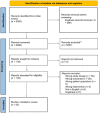Abortion and contraception for incarcerated people: A scoping review
- PMID: 36996087
- PMCID: PMC10062621
- DOI: 10.1371/journal.pone.0281481
Abortion and contraception for incarcerated people: A scoping review
Abstract
Background: Women experiencing incarceration have higher rates of unmet contraceptive needs and rates of abortion than the public. Incarceration presents multiple potential barriers to accessing abortion and contraception care, including prison security protocols, prison locations, lack of access to care providers, stigma, and low health literacy. The objective of this scoping review is to understand the extent and type of evidence in relation to contraception and abortion access for people experiencing criminalization and incarceration.
Methods: We used the Joanna Briggs Institute methodology for scoping reviews and include empirical research with people experiencing criminalization or incarceration and/or with prison staff; with respect to prescription contraception or abortion access, while in custody or after having experienced incarceration/criminalization. Databases searched include CINAHL, APA PsycInfo, Gender Studies, Medline (Ovid), Embase, Sociological Abstracts, and Social Services Abstracts. The search yielded 6096 titles of which 43 were included in the review.
Results: Our search yielded 43 studies published between 2001 and 2021 across six countries. The studies included qualitative, quantitative, and mixed methods designs. The main outcomes of interest included contraceptive use; attitudes towards abortion, contraception, and pregnancy; and barriers to care. Barriers identified included lack of onsite access to options, contraceptive coercion by providers, financial costs, and disruptions to medical coverage and insurance status which incarcerated.
Discussion: Evidence indicates that people in prison face significant barriers to maintaining continuity of contraceptive methods, abortion access, and reproductive health guidance. Some studies articulated participants felt judged when discussing contraception with prison-based health care providers. Geographic location, out-of-pocket payments, and trust in health care providers were reported as barriers to access.
Conclusion: Incarceration presents considerable challenges to the access of contraception and abortion care. Future research should examine the interaction between institutional security policies and procedures on care seeking, the experiences of underserved and hyper-incarcerated groups, and the impact of being denied access to contraception and abortion and experiences of criminalization.
Copyright: © 2023 Paynter et al. This is an open access article distributed under the terms of the Creative Commons Attribution License, which permits unrestricted use, distribution, and reproduction in any medium, provided the original author and source are credited.
Conflict of interest statement
The authors have declared that no competing interests exist.
Similar articles
-
Abortion and contraception within prison health care: a qualitative study.BMC Womens Health. 2025 Jan 23;25(1):34. doi: 10.1186/s12905-024-03523-z. BMC Womens Health. 2025. PMID: 39849511 Free PMC article.
-
Sexual and Reproductive Health Outcomes among Incarcerated Women in Canada: A Scoping Review.Can J Nurs Res. 2022 Mar;54(1):72-86. doi: 10.1177/0844562120985988. Epub 2021 Jan 28. Can J Nurs Res. 2022. PMID: 33508956
-
Access and use of sexual and reproductive health services among asylum-seeking and refugee women in high-income countries: A scoping review.PLoS One. 2024 Nov 7;19(11):e0312746. doi: 10.1371/journal.pone.0312746. eCollection 2024. PLoS One. 2024. PMID: 39509374 Free PMC article.
-
Facilitators and Barriers to Contraceptive Use Among U.S. Servicewomen Who Had an Abortion.Mil Med. 2019 May 1;184(5-6):e417-e423. doi: 10.1093/milmed/usy340. Mil Med. 2019. PMID: 30535236
-
Does distance decrease healthcare options for pregnant, incarcerated people? Mapping the distance between abortion providers and prisons.Contraception. 2020 Apr;101(4):266-272. doi: 10.1016/j.contraception.2020.01.005. Epub 2020 Jan 23. Contraception. 2020. PMID: 31982415
Cited by
-
Abortion and contraception within prison health care: a qualitative study.BMC Womens Health. 2025 Jan 23;25(1):34. doi: 10.1186/s12905-024-03523-z. BMC Womens Health. 2025. PMID: 39849511 Free PMC article.
-
Threats to Women's Health in Prisons and Jails.JAMA Intern Med. 2025 Jan 1;185(1):5-6. doi: 10.1001/jamainternmed.2024.5066. JAMA Intern Med. 2025. PMID: 39527070 Free PMC article.
-
Newcomer youth's access to contraception care in Canada: A scoping review of qualitative evidence.PLoS One. 2025 Aug 4;20(8):e0327997. doi: 10.1371/journal.pone.0327997. eCollection 2025. PLoS One. 2025. PMID: 40758688 Free PMC article.
-
Determinants of access to primary healthcare for formerly incarcerated women transitioning into the community: a systematic review of the literature.BMJ Public Health. 2024 Oct 3;2(2):e000735. doi: 10.1136/bmjph-2023-000735. eCollection 2024 Dec. BMJ Public Health. 2024. PMID: 40018615 Free PMC article.
-
The experiences of family planning health professionals providing care to incarcerated patients: a qualitative study.BMC Pregnancy Childbirth. 2025 Aug 14;25(1):856. doi: 10.1186/s12884-025-07913-5. BMC Pregnancy Childbirth. 2025. PMID: 40813962
References
Publication types
MeSH terms
Substances
LinkOut - more resources
Full Text Sources
Medical



